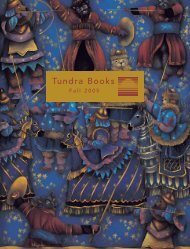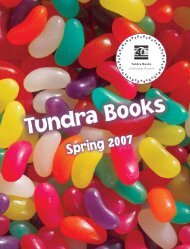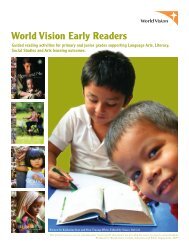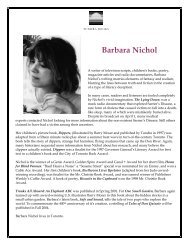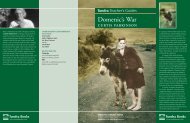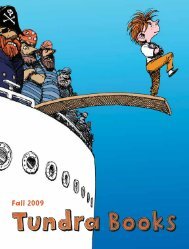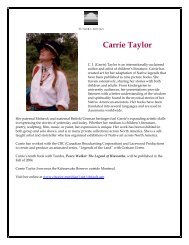Teacher's Guide - Tundra Books
Teacher's Guide - Tundra Books
Teacher's Guide - Tundra Books
Create successful ePaper yourself
Turn your PDF publications into a flip-book with our unique Google optimized e-Paper software.
Teacher’s <strong>Guide</strong> & Classroom Activities for<br />
Rescuing the Children: The Story of the Kindertransport<br />
by Deborah Hodge<br />
www.deborahhodge.com<br />
About the Book<br />
Rescuing the Children: The Story of the Kindertransport tells the story of<br />
ten thousand Jewish children who were rescued out of Nazi Europe and sent<br />
to safety in Britain just before the outbreak of World War II. Unlike most<br />
of their family members, these children (Kinder) survived the Holocaust.<br />
Their rescue shines a ray of light on this darkest of times.<br />
About the Holocaust<br />
The Holocaust was the state-sponsored persecution and murder of six<br />
million European Jews by the Nazi regime and its collaborators between<br />
1933 and 1945. Of the six million put to death, 1.5 million were children.<br />
Source: US Holocaust Memorial Museum.<br />
To learn more about the Holocaust and for teaching guidelines, please see<br />
the educator’s section on the US Holocaust Memorial Museum website at<br />
www.ushmm.org/education/foreducators.<br />
About the Kindertransport<br />
To learn more about the Kindertransport, please see the website of the<br />
Kindertransport Association at www.kindertransport.org. You can also find<br />
additional listings for related books, DVDs, and websites in the “Note to<br />
Parents and Teachers” on pp. 56-57 of Rescuing the Children.<br />
*Note to Teachers<br />
There is no easy way to tell young people about the Holocaust. It is a topic<br />
that requires the discretion of educators who will know the best time and<br />
approach for discussing this sensitive subject.
Please see the following pages for suggested topics for discussion and<br />
activities.<br />
Classroom Topics for Discussion and Activities<br />
Use the following discussion topics and activities to accompany the book,<br />
Rescuing the Children: The Story of the Kindertransport, and to engage your<br />
students in thinking about and discussing important issues of discrimination,<br />
persecution, diversity, and compassion.<br />
Many of the activities will be suitable for Language Arts (LA), Social Studies<br />
(SS), Social Responsibility (SR), Fine Arts (FA), or Math (M).<br />
Suggested Reading: “Terror in Germany” and “Voices of the Children”<br />
pp. 8-11<br />
Discussion Topics<br />
Even though you live in a different time and place, you may have seen bullying<br />
or experienced discrimination yourself. How did it make you feel? How would<br />
you feel if you were Ruth, Ellen, or Joseph?<br />
Activities<br />
(LA) Using a dictionary, look up the meanings of the following words:<br />
discriminate, persecute, and anti-Semitism. Give examples that show the<br />
meaning of each word.<br />
(SS) Ruth, Ellen, and Joseph suffered because of Nazi persecution. Make a<br />
list of anti-Semitic policies that were put in place in Nazi Germany during<br />
the 1930s.<br />
(SS/LA/SR) In partners or small groups, describe a situation of bullying,<br />
racism, or discrimination you have recently seen, experienced, or read about.<br />
Brainstorm a list of ways that people can stand up for others who are being<br />
persecuted or discriminated against.<br />
2
(M/SS) Take a poll of how many students in your class have experienced<br />
racism or other forms of bullying in the last month. What kind of bullying<br />
was it? Where did it take place? Graph the results.<br />
(SS/LA/SR) Write an anti-bullying code of conduct for your classroom or<br />
school.<br />
(FA/SR) Create an anti-bullying or anti-racism poster.<br />
(SS/LA/SR) Find out if there are children in the world today who are<br />
suffering from persecution. Write a letter to your government or other<br />
agency and ask them to help.<br />
Suggested Reading: “Desperate Times” and “The Night of Broken Glass”<br />
pp. 12-15<br />
Discussion Topics<br />
After Kristallnacht, Jews in Germany and Austria knew they were in terrible<br />
danger. Many tried to flee to other countries. Why do you think Jews were<br />
turned away almost everywhere? What would have happened if more<br />
countries had been willing to accept Jewish refugees?<br />
Activities<br />
(SS/M) Research which countries agreed to accept Jewish refugees in the<br />
1930s. Make a graph showing how many refugees each country accepted. Did<br />
your home country accept any Jewish refugees?<br />
(LA) Interview someone who has survived persecution in another country<br />
(past or present). If this is not possible, research an account of someone’s<br />
refugee experience by reading a newspaper, book, or searching the Internet.<br />
Share your findings (or personal story) with the class by writing an article or<br />
doing an oral presentation.<br />
(SS/LA) Research how many refugees are accepted per year in your country<br />
today. What countries do they come from? What are their reasons (consider<br />
3
war, persecution, famine, or other problems) for leaving their home<br />
countries? Present your findings in a written or oral report, or in a chart.<br />
Suggested Reading: “Getting Ready” and “Saying Good-bye”<br />
pp. 20-25<br />
Discussion Topics<br />
Imagine you had to leave your family and home and did not know when you<br />
would see them again. What would you pack? What would you leave behind?<br />
What would you say to your parents?<br />
Activities<br />
(FA/LA) Make a collage or list of items you would take with you. Everything<br />
must fit into one small suitcase. Create a drawing or list of the items you<br />
must leave behind. Describe how this would make you feel. Compare your<br />
lists with other students’ lists. How are they alike? How are they different?<br />
(LA) Write a good-bye note to a family member.<br />
(SS/LA) Bring a photograph or other possession from home and talk about<br />
its importance to you and your family.<br />
Suggested Reading: “The Journey” pp. 26-28<br />
Discussion Topics<br />
The Kinder escaped a dangerous situation and were greeted by friendly<br />
people in a safe place. How did this help them? What are some ways you can<br />
welcome newcomers to your school or community?<br />
Activities<br />
(LA) Of the Kinder who shared their stories in this section, who do you<br />
relate to most? Why? Write your answer or share it with the class in a<br />
discussion.<br />
4
(LA) Imagine you are one of the Kinder. Write a journal entry that describes<br />
your trip.<br />
(FA/LA) Make a postcard, with a drawing on one side and a short message on<br />
the other. Write it to a friend or family member you had to leave behind.<br />
(SS) Draw a map showing the journey of the Kinder. Or, trace their journey<br />
on a classroom wall map.<br />
(LA) In a class discussion or in writing, describe ways that a refugee’s<br />
journey would be the same or different today.<br />
(SS/SR) Find out about organizations or individuals in your area who help<br />
refugees settle into their new homes.<br />
(LA/SR) In partners or small groups, brainstorm ways to welcome newcomers<br />
to your classroom or school. Choose one to do over the next week or month.<br />
(SR) Host a multicultural day. Cook food from other countries or invite<br />
students to bring food that is important to their heritage.<br />
Suggested Reading: “Arriving in England” pp. 29-30<br />
Discussion Topics<br />
Picture yourself arriving alone in a new country, where you can’t speak the<br />
language and you don’t know the people you will be living with. How do you<br />
think the Kinder felt?<br />
Activities<br />
(FA/LA) Create a picture or newspaper article that features the Kinder<br />
arriving at Liverpool Street Station.<br />
(FA) Write and act out a short play of the Kinder arriving in England. Who<br />
meets them? Who helps?<br />
(LA) Compose a welcome message to the Kinder from the mayor of London.<br />
5
(SS/LA) Ask your parents about your background. Where is your family<br />
from? If they had to leave their home country, find out why. Consider<br />
writing or speaking about their experience and sharing it with the class.<br />
(FA) Make a drawing showing something from the Kinder’s journey (for<br />
example, boys hiding from enemy fire on the SS Bodegraven; the children’s<br />
train compartment being searched by the Nazi soldiers; or the Kinder being<br />
greeted by friendly Dutch citizens).<br />
Suggested Reading: “People Who Helped” and “The SS Bodegraven”<br />
pp. 31-35<br />
Discussion Topics<br />
Bertha, Nicholas, Norbert, and Truus risked their own lives to help the<br />
Kinder. Who of them do you admire the most? Why? Can you think of any<br />
equally courageous people who are alive today? What makes them brave?<br />
Activities<br />
(LA) Using a dictionary, look up the meaning of “courageous.”<br />
(SS) In small groups, or as a class, make a list of people (past or present)<br />
you think are brave or courageous. Consider checking the list of people<br />
honored as “Righteous Among Nations” at Yad Vashem: www.yadvashem.org.<br />
(SS/LA) Choose one courageous person to research. What makes him or her<br />
brave? Write a tribute or make a speech about this person.<br />
(LA) Select a person or group of people mentioned in the book who helped<br />
the Kinder and write them a thank-you letter.<br />
(SS/LA) Research one of the groups, such as the Society of Friends<br />
(Quakers), who helped the Kinder. Find out what work this organization does<br />
to help people today. Present your findings to the class in a written report or<br />
oral presentation.<br />
6
(FA) Courageous people are often honored with a statue or other memorial.<br />
Make a drawing or a sculpture out of modeling clay to honor someone you<br />
believe is courageous.<br />
Suggested Reading: “Life in Britain” pp. 36-38<br />
Discussion Topics<br />
What do you think was the most difficult aspect of the Kinders’ new life in<br />
Britain? Is there someone in your school or neighborhood who is trying to<br />
learn your language or the customs of your country? What are some ways<br />
you can help them?<br />
Activities<br />
(LA/SS) Make a list of problems or challenges the Kinder faced in Britain.<br />
Then make a list of problems or challenges that newcomers to your country<br />
face today. Compare them.<br />
(FA) North America is home to people from around the world. Create a<br />
multicultural collage or mural that celebrates this.<br />
(FA) Make a poster, flag, collage, or coat of arms that shows something<br />
about you and your heritage. As a class, display these together.<br />
(LA/FA)Team up with someone who speaks a different language than you.<br />
Create a ten word illustrated dictionary using words from both your<br />
languages.<br />
(LA) Learn some words and phrases in another language. Hold a conversation<br />
with one of your classmates.<br />
Suggested Reading: “The War Years” and “After the War”<br />
pp. 39-43<br />
Discussion Topics<br />
7
After the war, many of the Kinder were the only members of their family<br />
who had survived. Put yourself in their place and imagine what feelings they<br />
would have experienced on learning this terrible news. What would it be like<br />
to have to go on without your family?<br />
Activities<br />
(LA/SR) Hold a class discussion about war and its effects on people and<br />
their families. How can we take steps today to prevent future wars and<br />
persecution?<br />
(FA/LA) Look back at the paintings in the book by Hans Jackson and at the<br />
quilt squares created by the Kinder. Think about how art can communicate<br />
strong messages. Choose one of these pieces of art and describe what<br />
message you think it is communicating. Is there a strong message you’d like<br />
to communicate in art?<br />
(LA) In your own words, explain the meaning of the Jewish saying, “Whoever<br />
saves one life saves the world entire.”<br />
(SS) Is there is a Holocaust Education Center near you? Consider inviting a<br />
Holocaust survivor to your class to speak about his or her experience.<br />
Suggested Reading: “The Kinder Today,” “Reunions,” and “Remembering”<br />
pp. 44-50<br />
Discussion Topics<br />
What lessons do you think we can learn from the story of the<br />
Kindertransport? What do you think the Kinder were trying to say in their<br />
messages to you? What would you like to say to them?<br />
Activities<br />
(FA) Look closely at the quilt squares made by the Kinder to describe their<br />
experience. Create a similar square (using paper or fabric) that shows<br />
something meaningful about your life.<br />
8
(LA) On pages 45-46, the Kinder wrote messages to you. Write a message<br />
back to one or more of the Kinder you met in this book.<br />
(LA/FA) Write a short essay or poem, or create a piece of art that<br />
describes the most important thing you learned from the story of the<br />
Kindertransport.<br />
(LA) Read other children’s books about the Holocaust and the<br />
Kindertransport. A few examples are: Good-bye Marianne by Irene N.<br />
Watts, One Small Suitcase by Barry Turner, and Hana’s Suitcase by Karen<br />
Levine. Write a book review or do a book talk on one of them.<br />
(SS/SR) Find out about children in the world today who are suffering from<br />
discrimination, persecution, or war. Research organizations and individuals<br />
who are helping them. Send the helpers a note of support or a message<br />
asking what you can do to help.<br />
• Hold a bake sale or other fundraiser for an organization such as Unicef or<br />
Save the Children that helps children today.<br />
9




